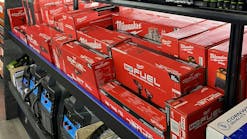R-1234yf: Cool profits in new A/C systems and tools!
Q - I’ve heard a lot about the new 1234yf refrigerant. How will this affect what I sell? How soon will my customers start asking me for these new tools and equipment?
A - Waiting until your customers ask you for any tools or equipment is a bad idea. Chances are once they start asking, it will be too late for you to catch up. If you want to have the edge over your competitors, you need to be the one that informs your customers about new tools first, even before they’re on your truck or in your catalog.
This month, I’m breaking with my usual sales and marketing format to give you a heads up on automotive refrigerant tools and equipment. Clip this column and save it so you’re prepared for the coming A/C tool trends – or use it to wrap fish. (I suggest the first.)
Beginning with 2013 models, a handful of OEMs switched several models of their vehicles from standard R-134a to R-1234yf refrigerant (see sidebar “Change Is In The Air [Conditioning]”).
What’s that mean to you? Everything. Top distributors know how automaker tool trends quickly trickle down to aftermarket tool trends.
Along with the new R-1234yf refrigerant systems will come many new tool requirements.
“(Tools and) equipment for R-1234yf has been (specially) designed to safely handle flammable gas,” says Mobile Air Conditioning Society President and COO Elvis Hoffpauir. The new equipment is not compatible with older refrigerants, and vice versa.
Don’t let the alphabet soup of SAE certifications below confuse you. But, it’s important to look for, and point out these certifications on the R-1234yf equipment that you sell. These machines will be more expensive than current R-134a machines, the rigorous requirements of these various certifications are the main reason and you’ll want to point that out to your customers.
Here’s a quick list of major A/C tools, equipment and technology and what, if any, changes you should expect to see over the next several years:
Recovery Equipment: Recovery-only units must be SAE J2851 certified to handle flammable refrigerant, says Mastercool, Inc. Senior Engineer Steve Gillespie.
Shops can’t use a machine designed for R-134a on R-1234yf; the service fittings are different, says Eric Shultz, Mahle Aftermarket Inc. service solutions vice president and engineering manager. Changing fittings is illegal and unsafe.
Recovery/Recycling/Recharging Equipment: RRR units must meet SAE J2843 standards and have an integrated refrigerant identifier or link to a compliant identifier (via an integrated USB port), says Gillespie.
“Due to increased safety and equipment specifications, service times for the machine process time are longer than the R-134a equipment,” says Shultz.
Dual Refrigerant Machines: A new J3030-certified dual refrigerant recovery, recycling, and recharging technology may be approved by SAE. Timing of an approval is uncertain.
“This is a dual-refrigerant machine that can be used for both R-134a and R-1234yf with the flick of a switch,” says Neutronics Inc. Vice President Peter Coll. “Anyone looking for a R-134a machine today should consider a J3030 machine that can be used today and tomorrow."
“We don't really know if a dual-refrigerant machine will be found acceptable,” Hoffpauir says. “However, it may be possible to develop a standard that would, at least, permit a single changeover (one time from say, R-134a to R-1234yf).”
Refrigerant Identifiers: “There’s a new (SAE J2913) standard for R-1234yf leak detectors,” says Gillespie. “R-1234yf is harder to detect than R-134a. It is also mildly flammable, so leak detectors that have very high temperatures, like corona discharge type sensors, should not be used.”
DOT Disposal Containers: “Due to cost, they are 10-lb cylinders,” says Ritchie Engineering Co., Inc. Director of Engineering Karl Johnson. It’s illegal to use a non-certified container for refrigerant disposal.
UV Dyes: “Most OEMs will supply systems with dye,” says Johnson. “The dye used is based on the type of oil in the compressor, not the type of refrigerant that is used in the system.” There are also universal dyes that can be used with all oil types (check dye specifications). Be aware some automakers do not support using dye in any system.
Refrigerant: Because, unlike R-134a, HFO1234yf is potentially flammable, there will likely be restrictions on if and how you can carry and transport containers on your truck.
Most A/C service tool and equipment experts agree that the demand for these products is still several years off.
“It is important for shop owners to carefully consider their business when making a decision on whether to purchase a (R-1234yf) compliant machine,” says Integrated Supply Network Product Manager Mike DuBois. “While the likelihood of seeing a vehicle with this gas on board is relatively low today and will continue to be so for the next few years; it is not an impossibility.”
“The real issue is the cost of the refrigerant (about $9 an ounce),” says Johnson. That and “the cost of equipping a shop to deal with 1234yf cars when there aren’t many around yet that are out of factory warranty and need A/C service.”
“Along with R-1234yf, there is additional effort being made to reduce the refrigerant leakage out of the system,” says Gillispie. “This means manufacturers can put less refrigerant in the systems, but it also means it will be longer until the systems need service. Which means that, other than collision repair shops and junk yards, the aftermarket repair shops should not need any tools for five to 10 years from now.”
Don’t expect to phase out your R-134a tool inventory for several years, but I hope you save this column so you can inform your customers, answer questions, and begin taking special orders ahead of your competition.
For downloadable handout and links to other online information resources on HFO1234yf that you can share with customers, go to http://philsasso.com/1234yf.
Change Is In The Air [Conditioning]
The changeover to R-1234yf refrigerant is not mandated by law in the US. It is, in part, being driven by a European deadline of 2017. Here are the nine vehicle models that have made the switch so far:
- Cadillac XTS (2013, 2014)
- Chevrolet Spark EV (2014)
- Chrysler 300 (2014)
- Dodge Challenger (2014)
- Dodge Charger (2014)
- Honda Fit EV (2013, 2014)
- Jeep Cherokee (2014)
- Range Rover (2014)
- Range Rover Sport (2014)


